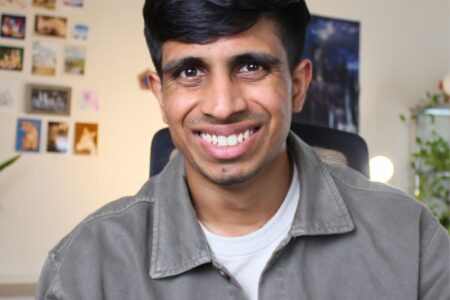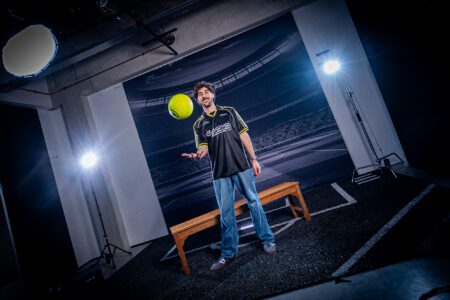
If you’re a student considering building your personal brand on LinkedIn, take a page from Ani Avetisyan.
She’s the co-founder and marketing director at AVE Digital, a B2B marketing agency, and the #1 LinkedIn creator in Armenia. With almost 20,000 followers, she knows what it takes to grow on the platform.
Ani started building her LinkedIn presence in her final year of university. At the time, she had around 500 connections, mostly people she already knew. She didn’t have a big plan. She simply began posting consistently around March. By May, when she co-founded AVE Digital, her following had grown to around 3,000.
“Honestly, I don’t think I would have co-founded this company if I hadn’t started building on LinkedIn,” she says.
That early momentum made a difference. Even with a small audience, she had already built credibility, shown her ideas, and connected with people who were paying attention. From there, her growth picked up speed. In just one year, her following jumped to over 15,000 — all of it was organic.
“Now is the perfect time,” she says. “LinkedIn is not saturated like other platforms. You can grow fast and stand out. The more visible you are, the more people and opportunities can find you.”
That’s why Ani encourages students to start now. You don’t need to wait for experience or a polished résumé. Just start sharing what you’re learning, what you’re thinking, and what you care about. Build your network early. Grow it before you need it.
By the time you graduate, you won’t just be looking for opportunities, you’ll have already created some.

Ani believes student years are the most adaptable, perfect for embracing challenges, learning fast, and building the resilience to handle anything. Source: Ani Avetisyan
From marketing student to startup founder
Born in Yerevan, Armenia, Ani would go on to earn a bachelor’s degree in business administration in Prague and a master’s degree in management and analytics in Armenia.
Her bachelor’s had focused on marketing. Now, she wanted a broader view — leadership, management, systems, analytics. The master’s programme delivered exactly that.
Just before classes started, she co-founded AVE Digital. Juggling both wasn’t easy, but she always knew a master’s degree was non-negotiable. It gave her something every founder needs: structure.
The analytical courses taught her to think in systems. The leadership modules sharpened her soft skills. Most of all, it changed the way she thought. She learned how to learn, how to adapt, and how to move through uncertainty with purpose.
“For a founder, these soft skills are essential, and that’s the deepest impact my master’s degree had on me,” she says.
With a master’s degree and experience with founding a start-up, Ani knows what it takes to stand out to businesses — in person and on the industry’s most important social media platform: LinkedIn.

Ani has always deeply valued education and genuinely enjoys academia. Source: Ani Avetisyan
How students can build a strong LinkedIn presence
For students starting on LinkedIn without connections, “networking” can feel overwhelming. But Ani always says: start where you are. That means connecting with professors, classmates, and alumni from your own university. These people already know you or at least share the same academic space. That shared context gives your connection requests meaning.
But don’t just hit the “connect” button and call it a day.
“Leave a short message when you connect,” she says. “Mention what you liked about someone’s post, ask a question, or share something you learned from them.”
Once you’ve started connecting, it’s time to get visible. Even with little experience, Ani believes students can use LinkedIn to land internships or job opportunities. The trick is to talk about what you’re learning. Ask thoughtful questions. And be active in the comments, especially on posts by people in the industry you’re studying. If you’re a marketing student, engage with marketing professionals and agencies. Don’t just watch, join the conversation.
“I’ve seen founders hire directly from LinkedIn without ever seeing a CV,” she says. “And I’ve read plenty of stories like that.”
In the early stages of your career, say yes to more. Volunteering, internships, even unpaid side projects, they all help you build confidence and clarity. And once your presence is strong, you won’t need to reintroduce yourself. Your work will speak for you.
To get there, posting regularly plays a big role. Ani started by sharing two to three posts a week. Now, depending on her schedule, she posts five to seven times. But consistency, not volume, is what made the difference early on.
“Most students think they have nothing to share because they’re not employees yet or don’t have experience, but that’s not true,” she says. “Start with the simple act of writing. It helps you clarify your ideas, articulate what you believe, what you’ve learned, and how you see the world.”

Ani advises aspiring student founders to build their personal brand so their story and vision don’t remain locked inside them. Source: Ani Avetisyan
For Ani, every student has something valuable to say. She sees student perspectives as a breath of fresh air, offering viewpoints professionals may have forgotten or overlooked. That contrast makes your content stand out.
She encourages students to start with what they already know. “Share what you’re learning in class,” she says. “Share insights from professors. Share the challenges you’re overcoming as a student or first graduate. Share new ideas, doubts, assumptions, and inspirations. All of it is content, and all of it is a signal.”
If you’re wondering how often to post, Ani suggests two to three times a week. Two is fine, but three is ideal. If you can do that consistently for a few months, you’ll begin to see results. It’s not just about the follower count, it’s about building momentum.
When asked about how she built her following, Ani keeps it simple: she writes for one person at a time, not for 10,000. Her approach is always audience-first. She focuses on pain points, questions, and the kind of content that adds value for her reader.
That audience-first mindset also helps her stay consistent, even on days when motivation is low. “Because consistency matters, and writing with intention matters,” she says. “Don’t just talk about your own struggles or what you like. Focus on what they care about and what they want to hear. That’s how you build real connection and value.”

At AVE Digital, Ani is building a space where creativity meets strategy and visibility becomes a business asset, focusing on the real voice of founders and executives rather than posting for the sake of it. Source: Ani Avetisyan
When it comes to tone, Ani walks a fine line. LinkedIn isn’t a personal journal, but that doesn’t mean it has to be cold. She encourages sharing real stories, personal challenges, and honest reflections, but always through the lens of what’s relevant to your audience. Keep it relatable. Keep it useful.
Some of Ani’s best-performing posts have followed this format. She mixes personal stories with actionable advice. A behind-the-scenes lesson one day, a clear technical tip the next. She’s found that people respond well to vulnerability, especially when it’s paired with something they can learn or apply.
“Posts where I talk about the truth of building, not just the wins, but also the tension and challenges behind the scenes, resonate a lot,” she says. “And students, especially, should remember: vulnerability connects. It always does. Be open. Be real. Be vulnerable. That’s how you build a strong and authentic network.”
Finally, there’s the question of formatting. Should every sentence be its own line? Ani doesn’t think so. She sees a lot of advice about short, skimmable posts, but warns against taking it too far.
“It depends on who you’re writing for,” she says.
“There are some ideas you simply can’t filter down into one short sentence, and you shouldn’t compromise a strong idea just to fit a format. The algorithm rewards good ideas, fresh takes, and real value. Of course, try to make your post as readable and clear as possible. Structure matters. But don’t assume that if you post a paragraph, no one will read it. That’s not true.”










